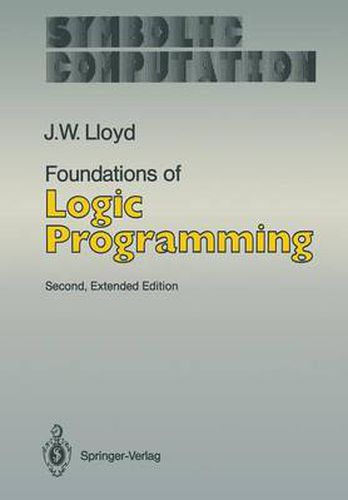Readings Newsletter
Become a Readings Member to make your shopping experience even easier.
Sign in or sign up for free!
You’re not far away from qualifying for FREE standard shipping within Australia
You’ve qualified for FREE standard shipping within Australia
The cart is loading…






This title is printed to order. This book may have been self-published. If so, we cannot guarantee the quality of the content. In the main most books will have gone through the editing process however some may not. We therefore suggest that you be aware of this before ordering this book. If in doubt check either the author or publisher’s details as we are unable to accept any returns unless they are faulty. Please contact us if you have any questions.
In the two and a half years since the frrst edition of this book was published, the field of logic programming has grown rapidly. Consequently, it seemed advisable to try to expand the subject matter covered in the first edition. The new material in the second edition has a strong database flavour, which reflects my own research interests over the last three years. However, despite the fact that the second edition has about 70% more material than the first edition, many worthwhile topic!! are still missing. I can only plead that the field is now too big to expect one author to cover everything. In the second edition, I discuss a larger class of programs than that discussed in the first edition. Related to this, I have also taken the opportunity to try to improve some of the earlier terminology. Firstly, I introduce program statements , which are formulas of the form A+-W, where the head A is an atom and the body W is an arbitrary formula. A program is a finite set of program statements. There are various restrictions of this class. Normal programs are ones where the body of each program statement is a conjunction of literals. (The terminology general , used in the first edition, is obviously now inappropriate).
$9.00 standard shipping within Australia
FREE standard shipping within Australia for orders over $100.00
Express & International shipping calculated at checkout
This title is printed to order. This book may have been self-published. If so, we cannot guarantee the quality of the content. In the main most books will have gone through the editing process however some may not. We therefore suggest that you be aware of this before ordering this book. If in doubt check either the author or publisher’s details as we are unable to accept any returns unless they are faulty. Please contact us if you have any questions.
In the two and a half years since the frrst edition of this book was published, the field of logic programming has grown rapidly. Consequently, it seemed advisable to try to expand the subject matter covered in the first edition. The new material in the second edition has a strong database flavour, which reflects my own research interests over the last three years. However, despite the fact that the second edition has about 70% more material than the first edition, many worthwhile topic!! are still missing. I can only plead that the field is now too big to expect one author to cover everything. In the second edition, I discuss a larger class of programs than that discussed in the first edition. Related to this, I have also taken the opportunity to try to improve some of the earlier terminology. Firstly, I introduce program statements , which are formulas of the form A+-W, where the head A is an atom and the body W is an arbitrary formula. A program is a finite set of program statements. There are various restrictions of this class. Normal programs are ones where the body of each program statement is a conjunction of literals. (The terminology general , used in the first edition, is obviously now inappropriate).